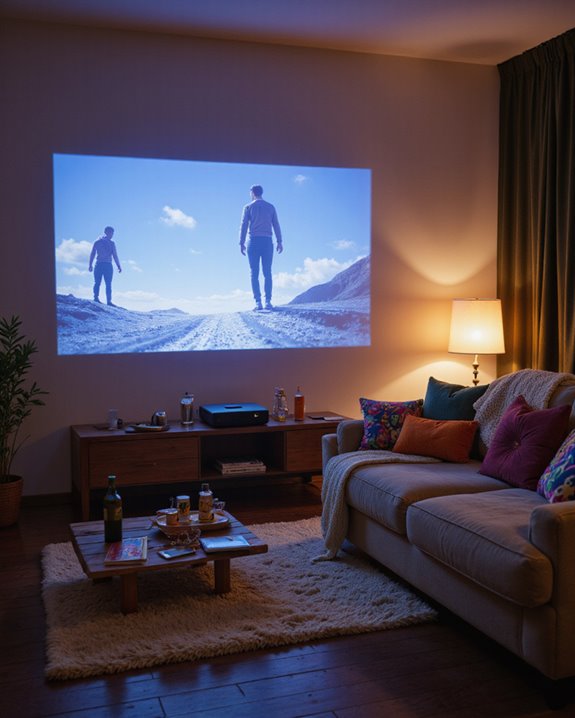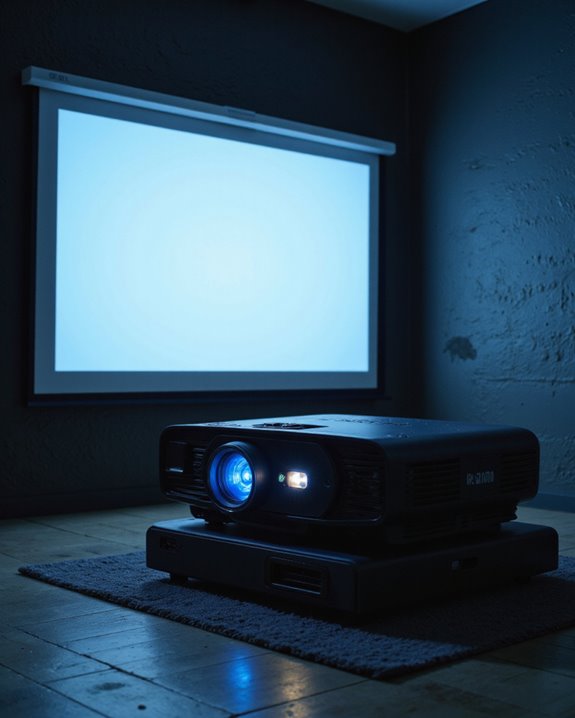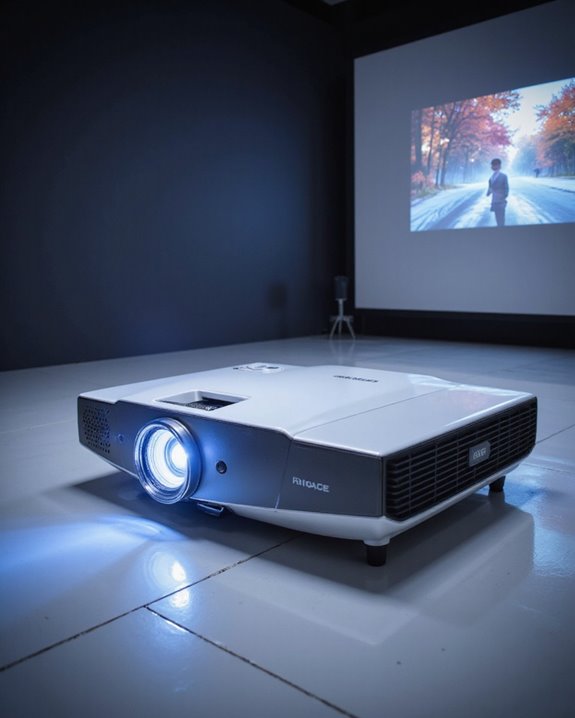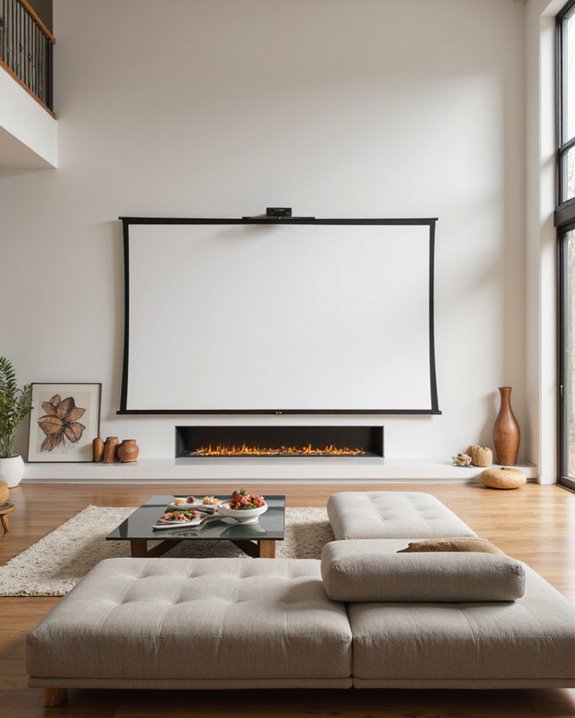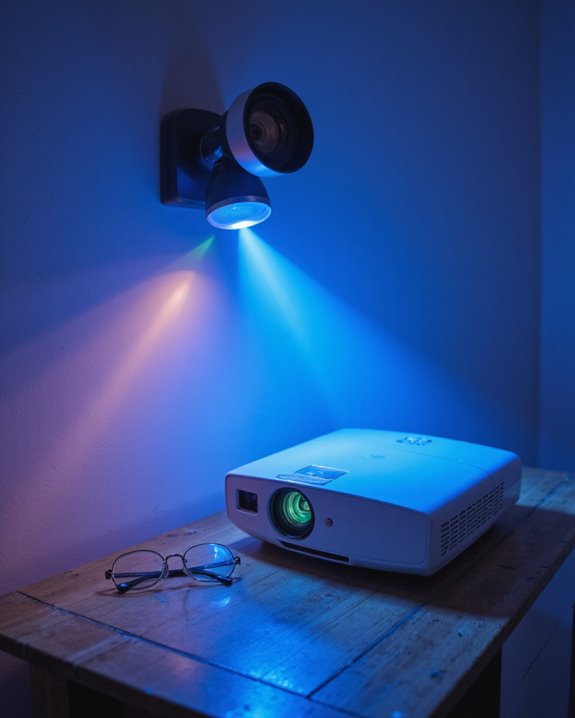Reddit users say projectors are worth it for those wanting a 100-inch or larger screen at a lower cost than most TVs. They highlight that 4K resolution projectors deliver sharp images, but performance depends on room lighting and projector brightness (measured in lumens). Maintenance, such as cleaning filters and replacing lamps, is needed. Built-in speakers are often weak, so using external audio systems is common. Setup is flexible and smart features are improving. More specific pros and cons are discussed further below.
Key Takeaways
- Projectors offer a cost-effective way to enjoy massive 100-inch+ screens compared to similarly sized TVs.
- Image quality has improved with 4K resolution, high brightness, and vibrant color performance, especially in controlled lighting.
- Long-term costs include replacing bulbs, filters, and potentially investing in better external speakers.
- Flexible setup options and smart features like built-in streaming apps increase convenience and usability.
- Reddit users recommend matching projector brightness to your room’s lighting and budgeting for regular maintenance.
Image Quality: How Modern Projectors Stack Up
Modern projectors have seen significant improvements in image quality, making them a strong choice for home theater and entertainment setups. Many models now offer 4K resolution, which means images appear sharp and detailed, even at larger screen sizes over 100 inches. Native 4K projectors provide better clarity than those using pixel-shifting, a technology that simulates 4K from lower-resolution chips. Color performance has improved, with some projectors covering the full DCI-P3 color space—the standard for digital cinema—resulting in vibrant, accurate images. Brightness levels, measured in lumens, can reach 3000 or more, helping projectors perform better in rooms with some ambient lighting. Laser projectors and dynamic iris technology further enhance contrast, delivering deep blacks and improved detail in both dark and bright scenes.
Cost and Value: Comparing Projectors to TVs
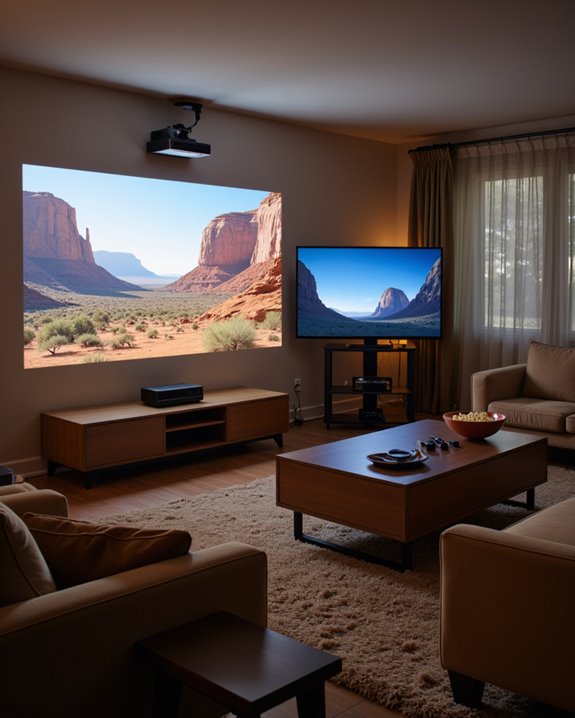
How do projectors and TVs compare when it comes to cost and overall value, especially for those seeking a large-screen experience? In a cost comparison, projectors generally provide a lower cost per screen inch, especially for screens above 75 inches. Entry-level 1080p projectors can cost less than $1,000, while comparable large TVs, especially OLED or QLED models, start at $2,000 and can go much higher for 75-inch or larger sizes. A value analysis shows projectors can deliver 100-inch or greater images for less than most similarly sized TVs. However, projectors often require extra spending on a screen, mounting hardware, and an external sound system. Despite these setup costs, the overall investment for very large screens often remains lower or comparable to premium TVs. Additionally, some projectors support 4K content and HDR10, enhancing image quality and making them more competitive with high-end TVs.
Setup Flexibility and User Experience
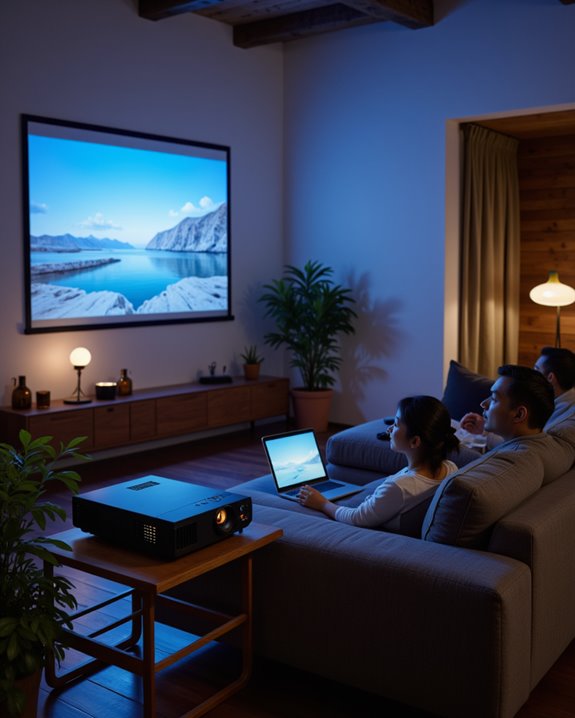
When considering home entertainment options, setup flexibility and user experience often distinguish projectors from traditional TVs. Projectors offer various mounting options, including ceiling and table mounts, which allow users to adapt their setup to different spaces. Room adaptability is a key benefit, as retractable screens and portable projectors can be installed or removed quickly, supporting both permanent and temporary arrangements. Users can select screen sizes and placements to fit unique room layouts, giving more control over the viewing environment. Key features include:
- Space-saving retractable screens that minimize obstruction when not in use
- Portable designs for easy transport between locations
- DIY installation options that allow for personalization and cost savings
- Many models support flexible placement options, including compact designs that facilitate versatile positioning and precise installation, enhancing the overall viewing experience.
Brightness and Room Conditions: What to Expect
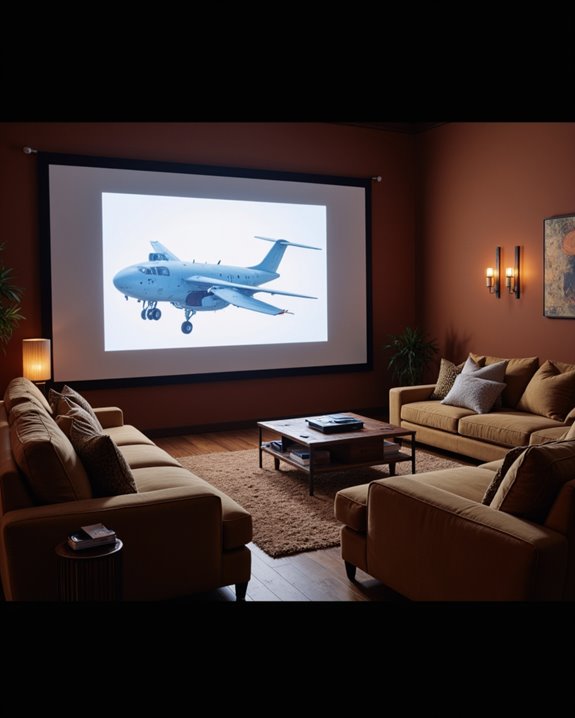
Projector brightness, measured in lumens—a unit indicating the total amount of visible light emitted—directly affects image clarity in different room conditions. To achieve sharp images, both ambient lighting and screen size must be considered. In a dark home theater, 1,000 to 2,500 lumens works well for screens up to 150 inches. Moderate ambient lighting, such as occasional lamps, requires 2,300 to 4,000 lumens. Bright rooms with sunlight or open windows call for 3,000 to 5,000 lumens, while large screens above 120 inches need at least 3,000 lumens even in dim rooms. Key factors include: More ambient lighting demands higher brightness. Larger screens dilute projected light. Projector brightness decreases over time, so initial overestimation is practical. Regular maintenance helps sustain ideal performance. Additionally, selecting a projector with adequate lumen output ensures consistent image quality across different environments.
Audio Performance: The Need for External Solutions
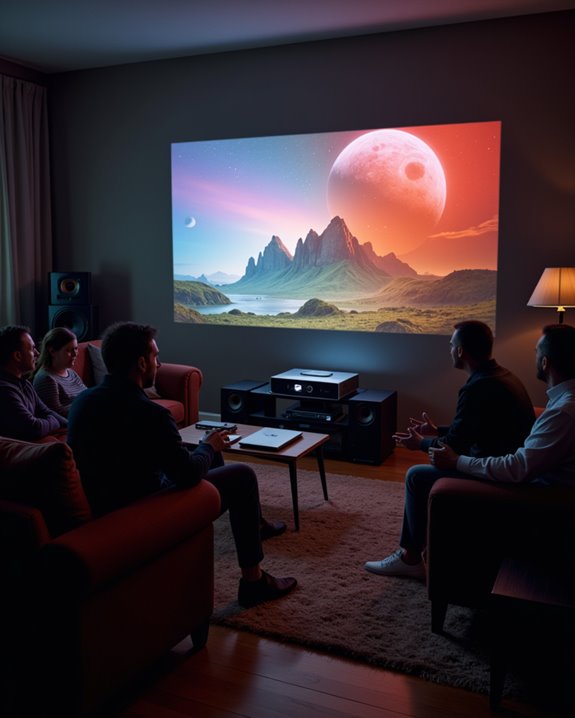
While brightness is a clear factor in creating a vivid image, audio quality often determines whether the viewing experience feels truly immersive. Most built-in projector speakers offer limited audio clarity and sound enhancement, with small drivers that struggle to deliver volume, bass, and dynamic range. Over time, these basic components tend to lose quality, and their uneven sound dispersion means audio coverage can be inconsistent across a room.
For improved performance, many users recommend external audio solutions such as soundbars or speaker systems. These options provide:
- Greater volume and bass response for more immersive sound
- Customization to suit room size and preferences
- Multiple connection methods: Bluetooth, HDMI, AUX, and RCA
Even with recent advances, built-in audio generally cannot rival the power and flexibility of dedicated external systems.
Smart Features and Streaming Capabilities
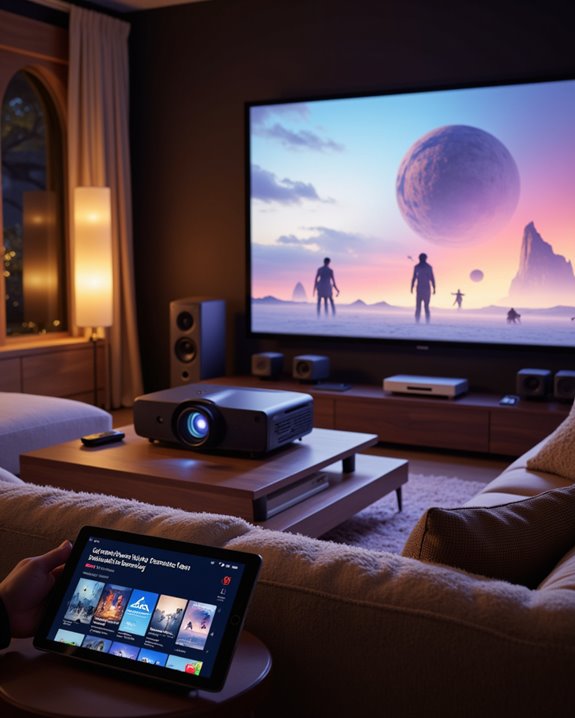
How do smart features and streaming capabilities change the way people use projectors today? Modern smart projectors offer built-in internet connectivity, allowing users to stream movies and shows directly—no external devices required. This smart integration means app compatibility is central; many models support popular streaming apps like Netflix, Hulu, and Amazon Prime Video. With systems such as Android TV, users benefit from a user-friendly interface and verified app support, ensuring reliable, high-quality playback.
Key advantages include:
- Direct streaming, reducing clutter and setup complexity
- Wireless connectivity through Wi-Fi or Bluetooth
- Interactive features like auto-keystone and auto-focus for easy setup
Some models, such as the Epson Home Cinema 2350, also provide 4K resolution and HDR (High Dynamic Range) for enhanced picture quality. Smart home integration adds further convenience.
Portability and Placement Options
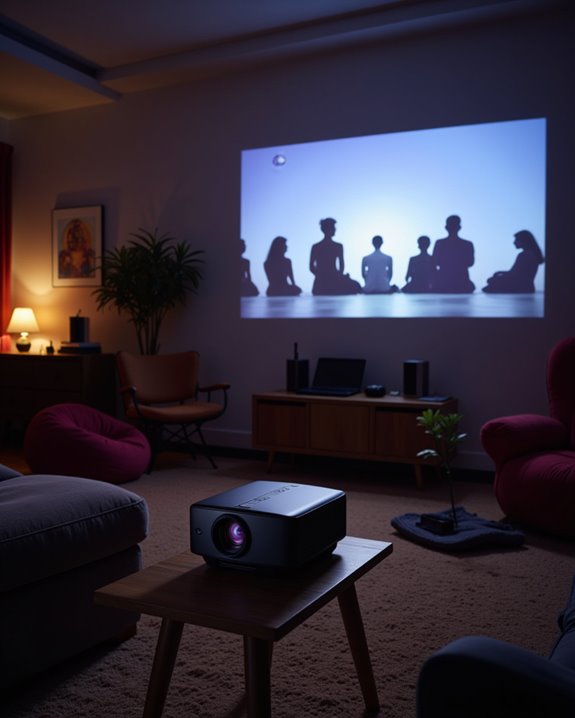
When considering the value of portability in modern projection technology, weight, size, and integrated features play a central role. Portable projectors, like the 3.7-pound XGIMI Halo+, are lightweight and compact, often fitting into backpacks or even cup holders for easy transport. Many models feature built-in batteries, enabling cordless operation in varied locations. Placement flexibility is supported by mounting options such as tripod mounts and adjustable screws, allowing stable setups on flat surfaces or tripods. However, portability trade offs exist. Smaller designs often limit brightness, speaker output, and connectivity options. Features like keystone correction and focus dials help optimize image clarity despite imperfect placement. Lacking optical zoom, users must move the projector physically for size adjustment. Multiple input ports enhance connectivity but may complicate cable management.
Use Cases: Home Theater, Gaming, and More
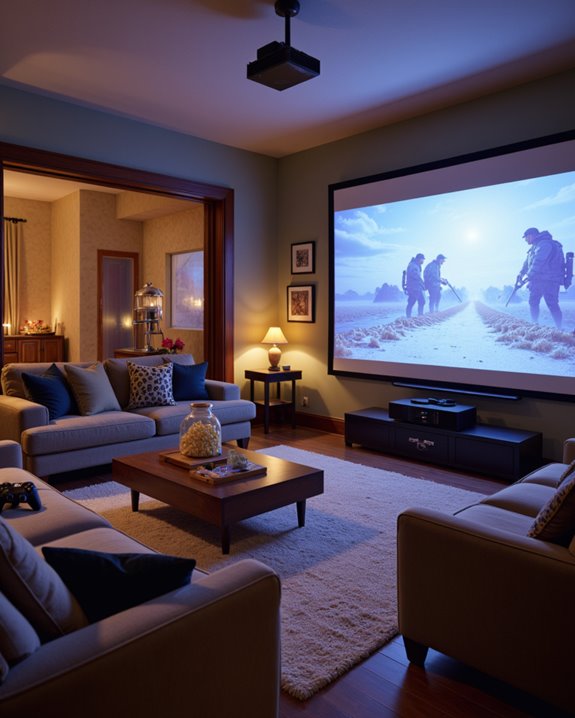
Projectors serve a wide range of uses, with home theater and gaming among the most prominent. They provide a large-screen experience, often displaying images up to 200 inches, making them ideal for immersive movie nights or gaming sessions. For home theaters, projectors offer flexible screen size, placement, and potential eye comfort advantages compared to traditional TVs. In gaming, advances in technology have improved response times and reduced lag, making projectors viable for fast-paced play. Key points include:
- Cost-effectiveness: Larger screen sizes at a lower price compared to TVs or monitors.
- Versatility: Suitable for business presentations, education, and outdoor events.
- Projector durability: Most units are designed for regular use, but lamp life varies.
- Maintenance requirements: Periodic lamp or filter replacements are necessary for idealperformance.
Real-World Feedback: What Reddit Users Recommend
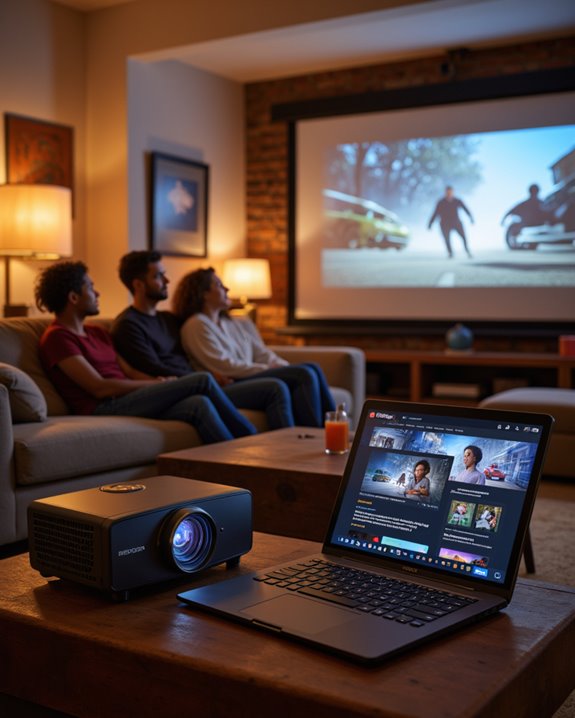
Among widespread opinions on Reddit, many users highlight that the key benefits of projectors are their ability to deliver very large screen sizes at lower costs compared to similarly sized televisions. When recommending projectors, Reddit users frequently share maintenance tips, such as regularly cleaning air filters and replacing lamps—consumable parts that determine image brightness and longevity. Brand comparisons are common, with users citing models from Epson, BenQ, and Optoma for reliability and image quality. Feedback also stresses the importance of matching projector brightness (measured in lumens) to room lighting, and selecting 4K resolution for sharper images. Recommendations typically include budgeting for external speakers, as built-in audio is often weak. Users advise considering long-term costs, including replacement bulbs, screens, and occasional repairs, when evaluating projector value.
Frequently Asked Questions
How Do Projector Maintenance Requirements Compare to TVS Over Time?
Contrasting maintenance routines, projectors demand regular screen calibration, dust cleaning, and occasional bulb or filter replacements, while TVs require minimal upkeep, focusing mainly on rare software updates. Projectors’ ongoing care stands in marked juxtaposition to TVs’ simplicity.
Are Projectors Safe for Children’S Eyes During Prolonged Viewing?
When considering child eye safety, projectors generally pose fewer risks than direct-view screens, but prolonged viewing effects may include eye strain or fatigue. Limiting screen time, ensuring proper distance, and maintaining ambient lighting can mitigate potential concerns.
Can Projectors Be Used for Outdoor Movie Nights Reliably?
Projectors can be used for outdoor movie nights reliably when users prioritize a portable setup, adequate brightness, and weather resistance. Reliability improves with stable screens, external speakers, and power backups, but performance may decline under challenging weather or lighting conditions.
How Do Projector Lamp or LED Lifespans Differ by Model?
In the theater of illumination, lamp longevity flickers like a candle—brief and bright—while LED durability shines as a steadfast lantern. Models with lamp bulbs typically last thousands of hours; LED projectors endure tens of thousands, requiring less maintenance.
What Are the Energy Consumption Differences Between Projectors and TVS?
Energy consumption varies: projectors typically use more power than modern TVs, but Eco-mode enhances energy savings. Projectors can offer larger screens with less energy than big TVs, impacting environmental impact positively when used efficiently and with lower brightness settings.

